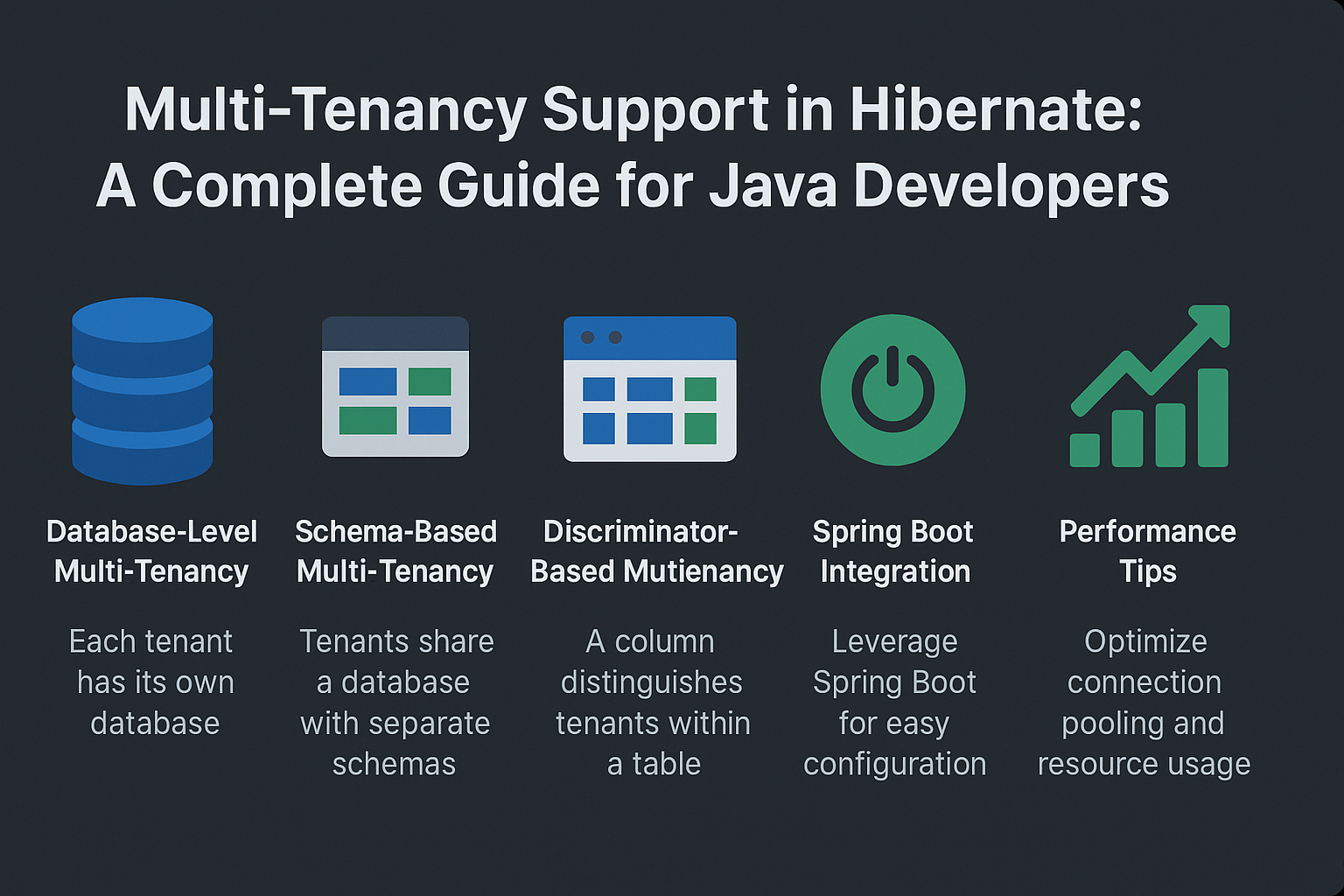In today’s cloud-first world, applications are often designed to serve multiple tenants — separate customers or organizations — within a single deployment. Each tenant may require logical data isolation while sharing the same application infrastructure.
Hibernate’s multi-tenancy support enables developers to efficiently manage multiple tenants in one system while ensuring data security, scalability, and maintainability. This guide covers the different approaches to multi-tenancy in Hibernate, configuration steps, integration with Spring Boot, and best practices for production.
What is Multi-Tenancy?
Multi-tenancy refers to an architecture where a single application instance serves multiple tenants (customers), while keeping their data isolated.
Key Multi-Tenancy Strategies in Hibernate:
- Database-level multi-tenancy: Each tenant has its own physical database.
- Schema-level multi-tenancy: Tenants share a database but have separate schemas.
- Discriminator-based multi-tenancy: A single schema and database with a tenant identifier column in each table.
Analogy: Imagine an apartment building:
- Separate buildings = Database-per-tenant
- Different floors = Schema-per-tenant
- Shared floor with labeled rooms = Discriminator column
Configuring Multi-Tenancy in Hibernate
Maven Dependency (Hibernate + Spring Boot)
<dependency>
<groupId>org.springframework.boot</groupId>
<artifactId>spring-boot-starter-data-jpa</artifactId>
</dependency>
<dependency>
<groupId>org.postgresql</groupId>
<artifactId>postgresql</artifactId>
<scope>runtime</scope>
</dependency>
Hibernate Properties for Multi-Tenancy
spring.jpa.properties.hibernate.multiTenancy=SCHEMA
spring.jpa.properties.hibernate.multi_tenant_connection_provider=com.example.MultiTenantConnectionProviderImpl
spring.jpa.properties.hibernate.tenant_identifier_resolver=com.example.CurrentTenantIdentifierResolverImpl
Implementing Schema-based Multi-Tenancy
MultiTenantConnectionProvider
import org.hibernate.engine.jdbc.connections.spi.MultiTenantConnectionProvider;
import javax.sql.DataSource;
import java.sql.Connection;
public class MultiTenantConnectionProviderImpl implements MultiTenantConnectionProvider {
private final DataSource dataSource;
public MultiTenantConnectionProviderImpl(DataSource dataSource) {
this.dataSource = dataSource;
}
@Override
public Connection getConnection(String tenantIdentifier) {
try {
Connection connection = dataSource.getConnection();
connection.setSchema(tenantIdentifier);
return connection;
} catch (Exception e) {
throw new RuntimeException("Could not switch schema for tenant " + tenantIdentifier, e);
}
}
}
CurrentTenantIdentifierResolver
import org.hibernate.context.spi.CurrentTenantIdentifierResolver;
public class CurrentTenantIdentifierResolverImpl implements CurrentTenantIdentifierResolver {
private static final String DEFAULT_TENANT = "public";
@Override
public String resolveCurrentTenantIdentifier() {
return TenantContext.getCurrentTenant().orElse(DEFAULT_TENANT);
}
@Override
public boolean validateExistingCurrentSessions() {
return true;
}
}
Tenant Context Utility
public class TenantContext {
private static final ThreadLocal<String> CURRENT_TENANT = new ThreadLocal<>();
public static void setCurrentTenant(String tenant) {
CURRENT_TENANT.set(tenant);
}
public static Optional<String> getCurrentTenant() {
return Optional.ofNullable(CURRENT_TENANT.get());
}
public static void clear() {
CURRENT_TENANT.remove();
}
}
CRUD Operations in a Multi-Tenant Environment
// Setting tenant dynamically
TenantContext.setCurrentTenant("tenant_a");
Session session = sessionFactory.withOptions()
.tenantIdentifier("tenant_a")
.openSession();
Transaction tx = session.beginTransaction();
Employee emp = new Employee();
emp.setName("Alice");
session.save(emp);
tx.commit();
session.close();
TenantContext.clear();
Each operation runs in the correct schema or database based on tenant configuration.
Querying with Multi-Tenancy
HQL Example
String hql = "FROM Employee e WHERE e.department = :dept";
List<Employee> employees = session.createQuery(hql, Employee.class)
.setParameter("dept", "Engineering")
.list();
Criteria API Example
CriteriaBuilder cb = session.getCriteriaBuilder();
CriteriaQuery<Employee> cq = cb.createQuery(Employee.class);
Root<Employee> root = cq.from(Employee.class);
cq.select(root).where(cb.equal(root.get("department"), "Engineering"));
List<Employee> result = session.createQuery(cq).getResultList();
Hibernate ensures tenant isolation by applying schema or database switching automatically.
Performance Considerations
- Connection Pooling: Ensure tenant switching doesn’t create overhead by using efficient pooling.
- Caching: Second-level cache works per-tenant; configure properly to avoid data leaks.
- Fetching: Use lazy loading (like “ordering food only when you need it”) to reduce tenant cross-load.
- Materialized Views or Reporting DBs: Use separate reporting systems for heavy analytics.
Real-World Integration with Spring Boot
@Repository
public interface EmployeeRepository extends JpaRepository<Employee, Long> {
List<Employee> findByDepartment(String department);
}
With Spring Boot, tenant resolution can be integrated into filters or interceptors to set the tenant context per request.
Common Pitfalls
- Forgetting to clear tenant context → may leak data between requests.
- Using eager fetching in multi-tenant apps → increases memory and query costs.
- Poor caching setup → may cause cross-tenant contamination.
- Not defining clear tenant identifiers in discriminator-based strategies.
Best Practices
- Always isolate tenant contexts with ThreadLocal or request-scoped beans.
- Use
@Immutablefor read-only tenant-specific views. - Optimize schema updates with Flyway or Liquibase per tenant.
- Prefer schema-per-tenant for medium-scale apps, database-per-tenant for strong isolation, and discriminator for SaaS with lightweight tenants.
📌 Hibernate Version Notes
Hibernate 5.x
- Relies on
javax.persistencenamespace. - SessionFactory configuration through
hibernate.cfg.xmlis common. - Legacy Criteria API widely used.
Hibernate 6.x
- Migrated to Jakarta Persistence (
jakarta.persistence). - Enhanced query capabilities with SQL standard compliance.
- Streamlined SessionFactory bootstrapping and tenant connection handling.
Conclusion and Key Takeaways
- Hibernate supports database, schema, and discriminator-based multi-tenancy.
- Schema-based strategy is often the most balanced for SaaS applications.
- Always manage tenant identifiers securely and clear tenant context after each request.
- Hibernate 6 provides modern APIs for better tenant resolution and SQL support.
Key Takeaway: Multi-tenancy in Hibernate ensures scalability, security, and cost-effectiveness for enterprise and SaaS applications.
FAQ: Expert-Level Questions
1. What’s the difference between Hibernate and JPA?
Hibernate is an implementation of JPA (a specification). JPA provides the standard, Hibernate provides the framework.
2. How does Hibernate caching improve performance?
It reduces database hits by storing query/entity results in memory.
3. What are the drawbacks of eager fetching?
It loads all associations immediately, which can cause high memory usage and slow queries.
4. How do I solve the N+1 select problem in Hibernate?
Use batch fetching, JOIN FETCH, or entity graphs.
5. Can I use Hibernate without Spring?
Yes, Hibernate works standalone, but Spring Boot simplifies configuration.
6. What’s the best strategy for inheritance mapping?
Depends on use case: SINGLE_TABLE for performance, JOINED for normalized schemas.
7. How does Hibernate handle composite keys?
By using @Embeddable with @EmbeddedId or @IdClass.
8. How is Hibernate 6 different from Hibernate 5?
Hibernate 6 uses Jakarta Persistence, improved query APIs, and better SQL standard compliance.
9. Is Hibernate suitable for microservices?
Yes, but use schema-per-service and avoid shared connection pools for strict isolation.
10. When should I not use Hibernate?
Avoid Hibernate when extreme performance is required, or when working with schema-less/NoSQL systems.
